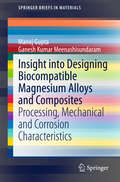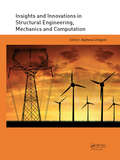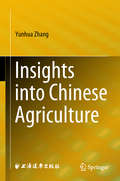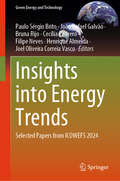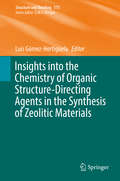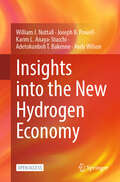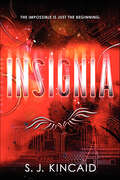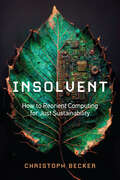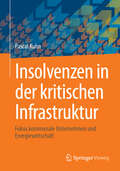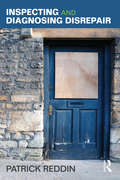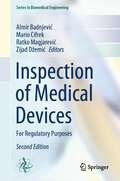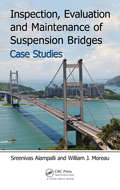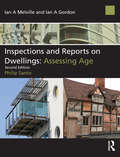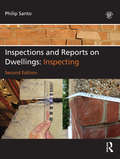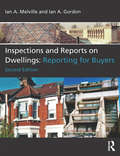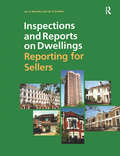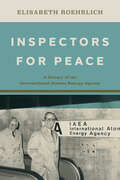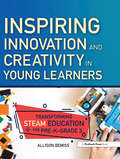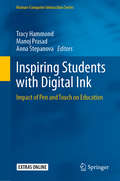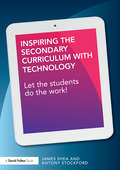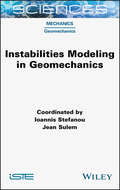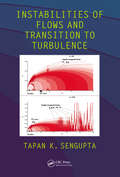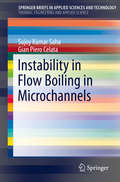- Table View
- List View
Insight - Quarterly Magazine Issue- 34 Oct-Dec 2024
by Justin PhilipsIt is a General magazine, presents a diverse collection of expert insights, emerging trends, and in-depth analyses on current affairs, technology, business, and culture.
Insight into Designing Biocompatible Magnesium Alloys and Composites
by Manoj Gupta Ganesh Kumar MeenashisundaramThis book critically summarizes the effects of various suitable alloying elements and particulate reinforcements on mechanical and degradation properties of pure Mg and Mg alloys targeting biomedical applications. The suitability of alloying elements and particulate reinforcements are discussed based on their levels of toxic effects on human body. First attempt is made to study and discuss on the various available synthesizing techniques for fabrication of both impermeable and porous Mg materials. Further, more emphasis on development of new magnesium matrix nanocomposites (MMNC) is made owing to the similarities between natural bone and MMNCs as bio-"nanocomposite". The information on synthesis, toxicity of alloying elements and reinforcements and their effects on mechanical and degradation properties of pure Mg will enable the researchers to effectively design Mg alloys and composites targeting biomedical applications.
Insights and Innovations in Structural Engineering, Mechanics and Computation: Proceedings of the Sixth International Conference on Structural Engineering, Mechanics and Computation, Cape Town, South Africa, 5-7 September 2016
by Alphose ZingoniInsights and Innovations in Structural Engineering, Mechanics and Computation comprises 360 papers that were presented at the Sixth International Conference on Structural Engineering, Mechanics and Computation (SEMC 2016, Cape Town, South Africa, 5-7 September 2016). The papers reflect the broad scope of the SEMC conferences, and cover a wide range of engineering structures (buildings, bridges, towers, roofs, foundations, offshore structures, tunnels, dams, vessels, vehicles and machinery) and engineering materials (steel, aluminium, concrete, masonry, timber, glass, polymers, composites, laminates, smart materials).
Insights into Chinese Agriculture
by Yunhua Zhang Curtis EvansThis book uses simple economic theories to explain how China's agricultural economic phenomena exists in reality. It also helps the reader to get a clear understanding of economic phenomena, insight into the "hog cycle" and "food safety," as well as other economic and social phenomena. The language of this book is not only easy to understand, but also uses ancient poetry and humor to make the subject interesting, as it speaks to the history and current situation of Chinese agriculture. It also opens a window for the people to read about agriculture. This is a unique book on agricultural science that fills an important gap in works on agricultural science and agricultural economics.
Insights into Energy Trends: Selected Papers from ICOWEFS 2024 (Green Energy and Technology)
by Joel Oliveira Correia Vasco Henrique Almeida João Rafael Galvão Paulo Sérgio Brito Bruna Rijo Cecília Pedrero Filipe NevesThis book presents selected papers from ICOWEFS 2024, addressing contemporary energy challenges. Topics range from energy and urban-industrial systems to governance issues, emphasizing the transformative potential of circular economy frameworks and the decarbonization imperative. It showcases innovative technologies, including energy-saving solutions, biofuels, and waste biorefining, paving the way toward sustainable energy systems. Readers will gain insights into smart technologies and the rise of hybrid local energy generation in this exploration of Energy 4.0's paradigm-shifting landscape.
Insights into the Chemistry of Organic Structure-Directing Agents in the Synthesis of Zeolitic Materials
by Luis Gómez-HortigüelaThis edited volume focuses on the host-guest chemistry of organic molecules and inorganic systems during synthesis (structure-direction). Organic molecules have been used for many years in the synthesis of zeolitic nanoporous frameworks. The addition of these organic molecules to the zeolite synthesis mixtures provokes a particular ordering of the inorganic units around them that directs the crystallization pathway towards a particular framework type; hence they are called structure-directing agents. Their use has allowed the discovery of an extremely large number of new zeolite frameworks and compositions. This volume covers the main aspects of the use of organic molecules as structure-directing agents for the synthesis of zeolites, including first an introduction of the main concepts, then two chapters covering state-of-the-art techniques currently used to understand the structure-directing phenomenon (location of molecules by XRD and molecular modeling techniques). The most recent trends in the types of organic molecules used as structure-directing agents are also presented, including the use of metal-complexes, the use of non-ammonium-based molecules (mainly phosphorus-based compounds) and the role of supramolecular chemistry in designing new large organic structure-directing agents produced by self-aggregation. In addition the volume explores the latest research attempting to transfer the asymmetric nature of organic chiral molecules used as structure-directing agents to the zeolite lattice to produce chiral enantioselective frameworks, one of the biggest challenges today in materials chemistry. This volume has interdisciplinary appeal and will engage scholars from the zeolite community with a general interest in microporous materials, which involves not only zeolite scientists, but also researchers working on metal-organic framework materials. The concepts covered will also be of interest for researchers working on the application of materials after encapsulation of molecules of interest in post-synthetic treatments. Further the work explores the main aspects of host-guest chemistry in hybrid organo-inorganic templated materials, which covers all types of materials where organic molecules are used as templates and are confined within framework-structured inorganic materials (intercalation compounds). Therefore the volume is also relevant to the wider materials chemistry community.
Insights into the New Hydrogen Economy
by Joseph B. Powell William J. Nuttall Adetokunboh T. Bakenne Karim L. Anaya-Stucchi Andy WilsonThis open access book offers a comprehensive exploration of the future of the hydrogen industry. It builds upon insights gathered from a series of expert workshops and follow-on activity. International experts from various fields, including industry, public policy, and academia, engaged in dialogue and knowledge exchange, resulting in invaluable findings and observations. This book builds upon that process to offers an in-depth analysis of the key issues facing commercial hydrogen energy development in the late 2020s. It highlights how hydrogen has the potential to emerge as a major component of the global energy industry, aiding the decarbonization process. Among the important lessons learned, the book discusses how both hydrogen and electrification will both play a significant role in the energy sector, but hydrogen could emerge as the larger energy carrier, and the two developments will largely operate independently of each other. The book also highlights the significance of industrial infrastructure such as ports, pipelines, hubs, and clusters in scaling up hydrogen use. Finally, the book considers the importance of hydrogen purity for future applications and acknowledges the potential for geologically sourced hydrogen to be a vital component of supply in the future.
Insignia (Insignia Ser. #1)
by S. J. Kincaid"Insignia expertly combines humor with a disarming and highly realistic view of the future. The characters are real, funny, and memorable. You won't be able to put this book down."—Veronica Roth, #1 New York Times bestselling author of Divergent and InsurgentThe earth is in the middle of WWIII in Insignia, the first entry in S. J. Kincaid's fast-paced sci-fi adventure trilogy perfect for fans of Ender's Game.The planet's natural resources are almost gone, and war is being fought to control the assets of the solar system. The enemy is winning. The salvation may be Tom Raines. Tom doesn't seem like a hero. He's a short fourteen-year-old with bad skin. But he has the virtual-reality gaming skills that make him a phenom behind the controls of the battle drones.As a new member of the Intrasolar Forces, Tom's life completely changes. Suddenly, he's someone important. He has new opportunities, friends, and a shot at having a girlfriend. But there's a price to pay. . . .
Insolvent: How to Reorient Computing for Just Sustainability
by Christoph BeckerHow we can enact meaningful change in computing to meet the urgent need for sustainability and justice.The deep entanglement of information technology with our societies has raised hope for a transition to more sustainable and just communities—those that phase out fossil fuels, distribute public goods fairly, allow free access to information, and waste less. In principle, computing should be able to help. But in practice, we live in a world in which opaque algorithms steer us toward misinformation and unsustainable consumerism. Insolvent shows why computing&’s dominant frame of thinking is conceptually insufficient to address our current challenges, and why computing continues to incur societal debts it cannot pay back. Christoph Becker shows how we can reorient design perspectives in computer science to better align with the values of sustainability and justice.Becker positions the role of information technology and computing in environmental sustainability, social justice, and the intersection of the two, and explains why designing IT for just sustainability is both technically and ethically challenging . Becker goes on to argue that computing could be aided by critical friends—disciplines that draw on critical social theory, feminist thought, and systems thinking—to make better sense of its role in society. Finally, Becker demonstrates that it is possible to fuse critical perspectives with work in computer science, showing new and fruitful directions for computing professionals and researchers to pursue.
Insolvenzen in der kritischen Infrastruktur: Fokus kommunale Unternehmen und Energiewirtschaft
by Pascal KuhnDieses Buch befasst sich mit Insolvenzen von Unternehmen, welche kritische Energieinfrastruktur verantworten. Wirtschaftliche Schieflagen solcher Unternehmen können weit größere Kreise ziehen als Insolvenzen in anderen Wirtschaftszweigen. Das Buch ermöglicht einen Überblick und möchte Orientierung bieten für Verantwortliche in diesen Sondersituationen. Zielgruppe sind neben Geschäftsführern der kritischen Energieinfrastruktur auch Aufsichtsräte und politische Entscheider.
Insourcing Innovation: How to Achieve Competitive Excellence Using TRIZ
by David Silverstein Neil DeCarlo Michael SlocumInnovation is central to business success, yet no other aspect of business is as frustrating and out of control. Instead of occurring in fits and starts and strokes of genius, innovation needs to become an all-the-time event that‘s measurable, reliable, predictable, streamlined, and effective. Structured innovation is a key goal for every organization whereby they more effectively meet the needs of customers and operate more efficiently. Insourcing Innovation demonstrates how to transform business using the theory of inventive problem solving (TRIZ) along with applicable tools and techniques. Providing a practical framework, this book presents the tactical and strategic aspects of TRIZ, its methodology, and its components. Real-world case studies illustrate how TRIZ can be applied in an organization. It also discusses how structured innovation is part of total performance excellence, examining key aspects of business excellence and how they are related.
Inspecting and Diagnosing Disrepair
by Patrick ReddinInspecting and Diagnosing Disrepair provides housing officers, surveyors, landlords, tenants, lawyers and environmental health inspectors with the essential information they need to record, diagnose and remedy disrepair. Pat Reddin presents technical information methodically, including useful diagrams to help readers to develop an understanding of building materials and structures and to advise and take action on disrepair. The book is fully up to date with the latest legislation and is essential reading for environmental health professionals, surveyors and students alike.
Inspection of Medical Devices: For Regulatory Purposes (Series in Biomedical Engineering)
by Almir Badnjević Mario Cifrek Ratko Magjarević Zijad DžemićThis comprehensive guide invites nations worldwide to embark on a transformative journey, implementing independent third-party verification systems that ensure medical devices comply with both international and national regulations. Prepare to be captivated as we delve into the intricate processes, unveil essential procedures, and illuminate the paramount importance of establishing traceability for medical device measurements.Imagine a world where medical devices undergo rigorous independent safety and performance verification, guaranteeing the utmost reliability for patient diagnoses and treatment. This book takes you on a compelling exploration of precisely that vision. Focusing on cutting-edge diagnostic and therapeutic devices, it captures the very essence of the latest international directives and regulations, ensuring you stay ahead of the curve.This new edition goes beyond the conventional, delving into the realms of innovation and progress. Unveiling in-depth maintenance regimes within healthcare institutions, we provide you with invaluable insights into post-market surveillance. As the world embraces the transformative potential of artificial intelligence, we pave the way for evidence-based management of medical device maintenance—a concept poised to reshape the healthcare landscape.Imagine a future where medical devices are seamlessly integrated into the legal metrology system, while fully operational national laboratories for medical device inspection set new standards of excellence. This book vividly illustrates how such a powerful union can elevate the reliability of medical devices in diagnosis and patient care. Brace yourself for a paradigm shift that not only enhances efficacy but also leads to significant cost reductions within your country's healthcare system.Join us on this extraordinary journey as we unveil the untapped potential of medical device inspection. With our innovative approach and unrivaled expertise, together we can revolutionize healthcare, transforming the lives of countless patients worldwide. Get ready to be inspired, informed, and empowered—welcome to the future of healthcare!
Inspection, Evaluation and Maintenance of Suspension Bridges Case Studies
by Sreenivas Alampalli William J. MoreauAn Insiders' Guide to Inspecting, Maintaining, and Operating BridgesSuspension bridges are graceful, aesthetic, and iconic structures. Due to their attractiveness and visibility, they are well-known symbols of major cities and countries in the world. They are also essential form of transportation infrastructure built across large bodies of water. D
Inspections and Reports on Dwellings: Assessing Age
by Philip SantoIdentifying the age of a property is a fundamental step in understanding its form of construction and in being prepared to differentiate between the characteristic defects of that age of property and defects which are more unusual and may warrant particular care in investigation and assessment. This second edition of Inspections and Reports on Dwellings: Assessing Age updates the market context within which surveyors and valuers are now operating. In particular it has a new section on post-2000 properties, reflecting the profound impact of Government policies and environmental concerns on the modern urban landscape. The book is divided into thirteen age bands with over seventy color photographs of dwellings for each period. A commentary on each age band outlines the social, environmental and technical influences on properties being built at the time, helping to explain why they look as they do. A broad range of dwellings is covered: large and small, private and public sector, old and new, and particular features which help to place a dwelling within one of the defined periods are highlighted in comments on the photographs. This book is intended for all those engaged in inspecting dwellings, whether experienced, newly qualified or studying for appropriate qualifications to become members of professional institutions.
Inspections and Reports on Dwellings: Inspecting
by Philip SantoInspections and Reports on Dwellings is a three-volume series that comprehensively explores the process of independent professional home assessment required for the purchase of residential property. This fully updated second edition of Inspecting retains a focus on the needs of the surveyor to recognise and interpret the significance of observations on site, whilst updating the market context within which surveyors and valuers are operating. Inspecting includes a consideration of the important benchmarking by the Royal Institution of Chartered Surveyors (RICS) of three distinct survey service levels for independent surveyors and a review of the wider choice of survey options professional surveyors can now offer to potential clients in addition to the RICS Home Survey range. There is additional content on preparing for the inspection and on reporting, and there are expanded or completely new sections on a variety of subjects such as conservatories, renewable energy technologies, and innovative techniques and forms of construction. With over 500 colour illustrations and an enhanced structure, the new edition reflects the very latest approach to inspecting and reporting on services, risk and legal matters. This book is essential reading for all those engaged in inspecting dwellings, whether experienced, newly qualified or studying for appropriate qualifications to become members of professional institutions.
Inspections and Reports on Dwellings: Reporting for Buyers
by Ian A. Gordon Ian A. MelvilleThis new edition of Reporting for Buyers provides guidance for the surveyor on setting out the findings of the inspection in a clear, unambiguous and unequivocal way. The book provides a full, critical look at the current situation, describing the various types of report currently available to the public for commissioning. The limitations and attributes of these reports are discussed and their respective forms of advice considered in detail, together with the advice provided to buyers which is a legal requirement to Scotland. The authors stress the need for Surveyors to demonstrate their all-round abilities by putting themselves in their client’s shoes to provide advice appropriate to their needs and requirements. In doing so they set out a cogent criticism of the standardised forms of advice offered to buyers and the lack of transparency in how they are presented by comparing what is seen by the client and what is set out in the various guidelines available. Surveyors will find the site notes and sample reports invaluable in demonstrating how the same dwelling can be described in the reports available. Sample reports include: mortgage valuation report RICS Condition Report RPSA Home Condition Survey Scottish Single Survey and the RICS Home Buyer Report. This book is intended for all those engaged in inspecting and reporting on dwellings, whether experienced , newly qualified or studying for appropriate qualifications to become members of professional institutions. It will also be found useful to conveyancing solicitors acting for lenders.
Inspections and Reports on Dwellings: Reporting for Sellers
by Ian Gordon Ian MelvilleInspections and Reports on Dwellings is a series of four books, the first three of which have already been published to considerable success. This concluding book covers reports prepared before dwellings are put on the market for sale, whether as a legal requirement or on a voluntary basis. All take into account guidelines laid down by the Courts for this type of work. Sellers’ surveys are not new, but only now have standard formats been developed. In England and Wales this is the Home Condition Report, with its Energy Performance Certificate, which can only be prepared by Licensed Home Inspectors. The Home Inspectors hold a Diploma in Home Inspection, sometimes with an add-on Certificate in Valuation of Residential Property for Secured Lending and they are members of a Government approved certification scheme. In Scotland each dwelling must have a Single Survey Report carried out before it goes on the market from 1 December 2008. The Single Survey Report describes the condition, sets out accessibility information, contains a valuation and energy reports. Initially only Chartered Surveyors will be authorised to do this work. Both Inspectors and Surveyors have to follow Codes of Conduct and Practice, carry professional indemnity insurance and allow their reports to be monitored to maintain standards – an entirely new concept. The book examines the relevant legislation and looks closely at the entire qualification and certification process for Home Inspector Valuers. Additionally the likely reaction of sellers, buyers and lenders are discussed. A substantial section is devoted to lending on dwellings and the practicalities of their valuation by the Comparative, Investment and Residual methods following the requirements of the ‘Red Book’. Four detailed sample reports are included to demonstrate how reports must be presented. The book is intended for all those engaged in the preparation of reports on dwellings whether experienced, newly qualified or studying. As well as being an essential book for surveyors it will also be of considerable interest to solicitors and estate agents, particularly those based in Scotland. The authors, experienced Chartered Surveyors, have written extensively on the diagnosis of defects in dwellings and are joint authors of the successful EG Books publication The Repair and Maintenance of Houses, 2nd edn.
Inspectors for Peace: A History of the International Atomic Energy Agency (Johns Hopkins Nuclear History and Contemporary Affairs)
by Elisabeth RoehrlichThe first comprehensive, empirically grounded, and independent study of the history of the IAEA.The International Atomic Energy Agency, which sends inspectors around the world to prevent states from secretly developing nuclear bombs, has one of the most important jobs in international security. At the same time, the IAEA is a global hub for the exchange of nuclear science and technology for peaceful purposes. Yet spreading nuclear materials and know-how around the world bears the unwanted risk of helping what the agency aims to halt: the emergence of new nuclear weapon states. In Inspectors for Peace, Elisabeth Roehrlich unravels the IAEA's paradoxical mission of sharing nuclear knowledge and technology while seeking to deter nuclear weapon programs. Founded in 1957 in an act of unprecedented cooperation between the Cold War superpowers, the agency developed from a small technical bureaucracy in war-torn Vienna to a key organization in the global nuclear order. Roehrlich argues that the IAEA's dual mandate, though apparently contradictory, was pivotal in ensuring the organization's legitimacy, acceptance, and success. For its first decade of existence, the IAEA was primarily a scientific and technical organization; it was not until the Treaty on the Non-Proliferation of Nuclear Weapons entered into force in 1970 that the agency took on the far-reaching verification and inspection role for which it is now most widely known. While the Fukushima nuclear disaster and the Iran negotiations made the IAEA's name famous, the organization's remarkable history remains strikingly absent from public knowledge. Drawing on extensive archival research, including firsthand access to newly opened records at the IAEA Archives in Vienna, Inspectors for Peace provides the first comprehensive, empirically grounded, and independent study on the history of the IAEA. Roehrlich also interviewed leading policymakers and officials, including Hans Blix and Nobel Peace laureate Mohamed ElBaradei, the agency's former heads. This book offers insight not only for students, scholars, and policy experts but for anyone interested in the history of the nuclear age, the Cold War, and the role of international organizations in shaping our world.
Inspiring Innovation and Creativity in Young Learners: Transforming STEAM Education for Pre-K-Grade 3
by Allison BemissInspiring Innovation and Creativity in Young Learners helps teachers and other educational stakeholders to promote innovative thinking in children in Pre-K through grade 3. This book shares six easy-to-understand, yet powerful, steps that teachers can take to transform the learning experience into one in which critical and creative thinking are encouraged.
Inspiring Students with Digital Ink: Impact of Pen and Touch on Education (Human–Computer Interaction Series)
by Tracy Hammond Manoj Prasad Anna StepanovaThis book highlights the latest research in pen and touch, its current use in STEM classrooms, sketching and haptics technologies. Computer and educational scientists from academia and industry presented their research at the Conference on Pen and Touch Technology on Education (CPTTE) 2017 on the advancement of digital ink technology and its applications for college and K-12 classrooms. This book is the synthesis of the presented results and the ideas generated from conference discussions. This volume contains seven parts; exploring topics like sketching forensics, teaching STEM, sketch recognition applications, creating a learning environment with sketching, teaching to sketch, and haptics. The book focuses on intelligent systems using digital ink that enable pen and touch interaction that teach and inspire students. Inspiring Students through Digital Ink is a must-read for anyone wanting to improve today’s student experiences and apply innovative approaches in the classroom. Also highlighted are current and future directions in pen and touch research.
Inspiring the Secondary Curriculum with Technology: Let the students do the work!
by James Shea Antony StockfordAre other teachers using technology in their lessons? Are you letting your own students down by not harnessing the power of your students’ technology knowledge in your lessons? Is your school asking you to show where you are developing ICT in your subject teaching? Technology in your subject does not mean teaching databases, spreadsheets or word processing. Having technical knowledge is no longer sufficient or indeed necessary in today’s world – more important is the knowledge of how to advise and teach students to use technology efficiently and responsibly through their subject. Students faced with a ‘problem’ will need to hunt the internet for open source software, download apps and respond to the problem using technology as a problem solving tool. The scenarios are endless, but can be generated by the teacher - this could mean students publishing work through Amazon’s Kindle or keeping a blog within a class wiki. Teachers do not need to have technical knowledge; rather they need knowledge of trends and opportunities. They then need to blend their basic subject pedagogy within these new trends to contextualise ICT skills. This book looks at pedagogical approaches to using technology in the classroom that will help you to harness future trends, technology and software and embed them into your subject teaching. Full of practical advice, it illustrates how secondary teachers – of any discipline – can accelerate their students’ learning, progress and ability within their subject whilst developing the ICT skills needed in the workplace and society. Including case studies and examples throughout, chapters cover: Blended Learning (mixing traditional teaching methods with e-learning) Developing interactive students Mobile technologies Student safety online E-Portfolios and Virtual Learning Environments This timely new book will help you structure your teaching to harness the latest developments in technology in tandem with the students you teach.
Instabilities Modeling in Geomechanics
by Jean Sulem Ioannis StefanouInstabilities Modeling in Geomechanics describes complex mechanisms which are frequently met in earthquake nucleation, geothermal energy production, nuclear waste disposal and CO2 sequestration. These mechanisms involve systems of non-linear differential equations that express the evolution of the geosystem (e.g. strain localization, temperature runaway, pore pressure build-up, etc.) at different length and time scales. In order to study the evolution of a system and possible instabilities, it is essential to know the mathematical properties of the governing equations. Therefore, questions of the existence, uniqueness and stability of solutions naturally arise. This book particularly explores bifurcation theory and stability analysis, which are robust and rigorous mathematical tools that allow us to study the behavior of complex geosystems, without even explicitly solving the governing equations. The contents are organized into 10 chapters which illustrate the application of these methods in various fields of geomechanics.
Instabilities of Flows and Transition to Turbulence
by Tapan K. SenguptaThis book covers material ranging from classical hydrodynamic instability to contemporary research areas, including bluff body flow instability and mixed convection flows. It also examines applications in aerospace and other branches of engineering such as fluid mechanics. The author addresses classical material as well as new perspectives and presents comprehensive coverage of receptivity to complement the instability material. This book presents a concise, up-to-date treatment of theory and applications of viscous flow instability, providing both current knowledge and techniques.
Instability in Flow Boiling in Microchannels
by Sujoy Kumar Saha Gian Piero CelataThis Brief addresses the phenomena of instability in flow boiling in microchannels occurring in high heat flux electronic cooling. A companion edition in the SpringerBrief Subseries on Thermal Engineering and Applied Science to "Critical Heat Flux in Flow Boiling in Microchannels," and "Heat Transfer and Pressure Drop in Flow Boiling in Microchannels,"by the same author team, this volume is idea for professionals, researchers, and graduate students concerned with electronic cooling.

